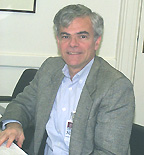| T
H E N I H C A T A L Y S T |
J
U L Y – A U G U S T
2002 |
|
| F R O M |
T H E |
D E P U T Y |
D I R E C T O R |
F O R |
I N T R A M U R A L |
R E S E A R C H |
SPECIAL
INTEREST GROUPS:
AN
ASSESSMENT
 |
| Michael
Gottesman |
SMALL
WORKING GROUPS OF SCIENTISTS WITH SIMILAR INTERESTS DRIVEN BY SPECIFIC
MOLECULES, METHODOLOGY, AND MODEL ORGANISMS SPRANG UP QUICKLY,
AND THIS
CURRENT ISSUE OF
THE
NIH CATALYST LISTS A TOTAL OF 89 SIGS
|
The
concept of special interest groups (SIGs)
at NIH was formalized eight years ago, shortly after I became DDIR and
with the strong encouragement of Harold Varmus, who had just assumed the directorship
of NIH.
The idea grew out of the
important contributions made by pre-existing grassroots trans-NIH scientific
groups such as the Lambda Lunch (bacterial and phage genetics), structural biology,
glycobiology, and immunology. Similar in concept was a major recommendation
of the 1992 Klausner committee report on intramural administration that suggested
that the creation of "faculties" at NIH would give scientists a stronger
voice in decision-making about science issues at NIH.
We started with six cross-cutting
SIGs (structural biology, immunology, cell biology, molecular biology and biochemistry,
neurobiology, and genetics) and added clinical research shortly thereafter.
Small working groups of scientists with similar interests driven by specific
molecules, methodology, and model organisms sprang up quickly, and this current
issue of The NIH Catalyst lists a total of 89 SIGs.
Although the level of
activity of these groups varies, many have a regular seminar series and occasional
workshops, and they provide a support group for trainees and new scientists
entering a particular research area.
The Office
of Intramural Research and the Office
of the Director, NIH, support websites and cost of conference facilities
and also have a small budget to help defray the cost of bringing speakers to
a few special SIG-sponsored workshops.
In addition, the SIGs
assist with the Research Festival, nominate
speakers for the NIH Director’s Wednesday
Afternoon Lecture Series, and contribute in a major way to the high quality
of speakers who come to NIH.
Overall, my sense is that
the SIGs have been a successful experiment, leading to collaborations across
institutes and giving scientists a stronger voice in obtaining resources and
recruiting colleagues to the intramural program.
Our tenure-track scientists
have told me how much they appreciate finding like-minded colleagues quickly
after their arrival at NIH, and I frequently use the SIGs as a source of advice
when I am looking for experts in a specific scientific area. Good suggestions
about how to do things better at NIH have come from the SIGs, whose chairs I
meet with annually.
How can we strengthen
the effectiveness and influence of the SIGs at the NIH? Our new director, Elias
Zerhouni, has challenged our scientific directors to help define biomedical
research bottlenecks and knowledge gaps that can be filled by intramural research
activities and infrastructure. Can we use the existing SIGs more effectively
to identify areas of research and infrastructure requirements in which the intramural
program should be taking a lead?
Current exciting opportunities
in neuroscience, functional imaging, structural biology, and immunology, including
vaccine development, among many others, have benefited from the interactions
between the scientific leadership at NIH and the SIGs. As new areas of research
develop (for example, stem cell biology), can we use the SIGs to mobilize interest,
define needed resources, and provide direction in support of such activities?
Historically, our SIGs
and other trans-NIH groups have provided a useful focus for concentrating talent
and resources on problems of importance to the scientific community at large.
For example, the development
of recombinant DNA technology was given a boost by the concentration of phage
and bacterial geneticists at NIH; advances in HIV research benefited from the
large concentration of retrovirologists and HIV researchers at NIH; trans-NIH
imaging activities have made us a leader in this area; array users have helped
spread this research tool quickly in the Intramural Research Program.
I would appreciate feedback
on how the SIGs can be even more effective than they are now, especially in
the development of new research areas. As always, I welcome and encourage your
thoughts on this issue.
—Michael
Gottesman
Deputy
Director for Intramural Research
Return to Table of Contents
